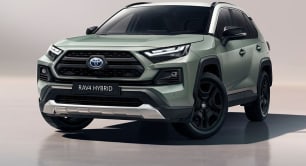At just over 4.7m long, close to 1.9m wide and 1.75m tall, the Outlander is a ‘large’ medium-size SUV.
There’s lots of breathing room up front and the car is wide enough that the driver and front passenger aren’t bursting each other's personal space bubbles.
Within the car’s overall footprint, a 2.7m wheelbase (the distance between the axles) is pretty generous and rear seat room is good, too.
Sitting behind the driver’s seat set for my 183cm position I enjoyed more than adequate head, leg and shoulder room.
Three full-size adults across the second row are okay for up to medium length trips, thanks in no small part to a flat rear floor. And depending on the child seats or boosters you’re working with, three-abreast for smaller humans should be do-able, as well.
Storage options in the front include a medium-size lidded box between the seats (which doubles as a centre armrest), a reasonable glove box, two big cupholders in the centre console and generous bins in the doors with space for large bottles.
The wireless charging pad is handy for your phone (even when it’s not charging) as well as other bits and pieces. And an overhead bin flips down for your sunnies.
There are directional air vents for those in the rear with storage running to a shelf underneath the vents, map pockets on both front seat backs, two large cupholders in the fold-down centre armrest and slots in the doors, again with space for larger bottles.
Move to the third row, and… you’ll be cramped. Mitsubishi is up front in positioning this car as a ‘5+2’, meaning full-time seating for five and (very much) part-time seating for two.
Those two in the way-back seats will be small kids, on short trips, and even then, the sliding (and reclining) middle row will need to move forward quite a bit to accommodate their legs. Adults? Forget it.
Power and connectivity options include primary USB-A and USB-C sockets for media in the dash plus another two outlets in the rear for power only. There are 12-volt plugs in the front and the boot.
Speaking of which, the boot will accommodate 163 litres (VDA) worth of stuff (to the top of the seats) with the third row upright, which is enough for some shopping bags, school bags, etc.
Folding that 50/50 split-folding row down means removing the ludicrously long (but undoubtedly effective) head restraints for a flat-floor load space of 478 litres (VDA).
We were able to load in the large CarsGuide pram, with room to spare, and our three-piece luggage set (36L, 95L and 124L) was also swallowed easily.
Lower the 40/20/40 split-fold second row seat and you have 1461 litres (VDA - to the roof) at your disposal.
There are small storage areas either side of the load space behind the wheel tubs and tie-down anchors to help keep loose loads under control.
The Outlander LS Black Edition is rated to tow a 1.6-tonne braked trailer (750kg unbraked) with ‘Trailer Stability Assist’ standard, and the spare is a space-saver.












.png)



















































.png)























 copy.png)
















